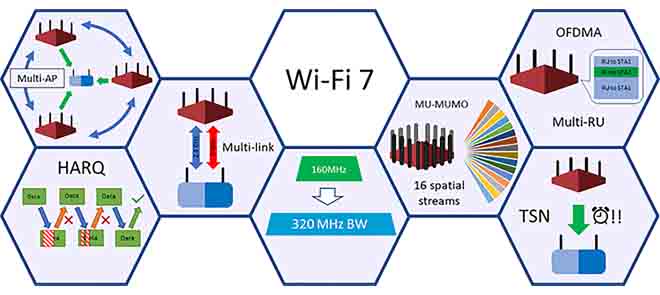As networking devices with Wi-Fi 6 are becoming widely available and relatively affordable, tech companies are already looking ahead to implement Wi-Fi 7 in their products and services.
This new standard — currently known as 802.11be —focuses on Extremely High-Throughput (EHT) that can aid real-time apps with high data speeds. The IEEE working group said it’ll help services in virtual reality, augmented reality, gaming, and remote working.
In its current form, here’s how Wi-Fi 7 will compare to Wi-Fi 6 (and even Wi-Fi 6E).
For the uninitiated, Wi-Fi 6 is the standard current standard present in many routers that support 9.6Gbps data transfer speeds — as compared to 3.5Gbps of Wi-Fi 5 — and higher throughput. While Wi-Fi 6E is largely based on the Wi-Fi 6 standard, it brings support for the 6 GHz spectrum, and high-bandwidth channels to cater to more devices on a single high-speed network. You can read more about it here.
Keep in mind that the standard is in the draft stage, and the final specifications might be different when they’re published.
Wi-Fi 6 vs. Wi-Fi 7
Don’t worry if you don’t immediately grasp every spec below, I’ll explain them all in a second.
- Data transfer speed: 9.6Gbps vs. 46Gbps (approx)
- Channel bandwidth: 160MHz vs. 320MHz
- Number of full-bandwidth channels: 7 vs. 6
- Spatial streams for multi-user MIMO: 8 vs. 16
- Data transmission: 1024-QAM vs. 4096-QAM


What does this mean?
First, the 46Gbps data transfer speed is a theoretical maximum; real-life figures will likely reach around 40Gbps. That means you can technically download a Blu-Ray quality movie file sized 25GB within seconds.
Second, The number of channels and bandwidth can impact quick data exchange between multiple devices. This will also determine how many devices can connect to one network point without any impact on speed.
The next-gen Wi-Fi will also allow 16 antennas for receiving and transmitting data. It’s important to keep in mind that most phones and laptops have a 2×2 MIMO (Multi-input Multiple-outputs) — two antennas for receiving (input) and two for transmitting (output)— configuration for Wi-Fi.
Having a 16×16 router could aid more devices with simultaneous 2×2 streams with a high data transfer speed and minimal interruptions.


QAM stands for Quadrature amplitude modulation (QAM) — a type of digital modulation for data exchange in telecommunication. It transmits data through symbols containing a specific number of bits. So higher the number, more data is conveyed in a given cycle. The new 4K-QAM can transmit 12-bits per symbol as compared to 10 bits of 1024-QAM. This is useful in dense environments like stadiums where many devices are trying to connect to a network.
When can we expect Wi-Fi 7 to reach us?
As Wi-Fi 7 is in the draft specification stage, it will take at least a few years for us to experience this tech. To use it at its full capacity, it’s imperative that the 6GHz band is unlicensed in your region, meaning you can use devices utilizing Wi-Fi 6E.
Countries such as the US, Canada, UK, South Korea, Brazil, and Saudi Arabia have allocated some spectrum in the given band, with more being added to the list.
But this hasn’t deterred tech companies from tinkering with Wi-Fi 7. Last night, MediaTek announced that it has started demoing capabilities of this upcoming standard to its key customers. However, it didn’t give out many details about the experiment.
The Taiwanese company said some Wi-Fi 7 powered devices will hit the market expectedly in 2023. However, these might be just prototypes or business devices. So don’t hold your breath.
You can read Wi-Fi 7’s full specifications in the current draft here.
